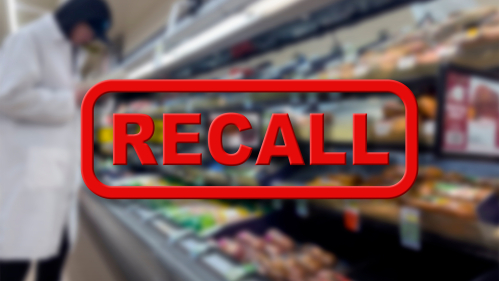Why Are There So Many Food Recalls Right Now and Should You Be Concerned?

Food recalls seem to be filling our news feeds recently.
The Centers for Disease Control and Prevention is investigating an E. coli outbreak linked to McDonald’s Quarter Pounders that has resulted in one death and made 49 people sick. The news followed a deadly listeria outbreak in Boar’s Head deli meat and a recent voluntary recall of frozen waffles due to potential listeria contamination.
Donald Schaffner, Distinguished Professor in the School of Environmental and Biological Sciences and a food safety expert, talked to Rutgers Today about the current outbreaks and what people should know.
What do we know about the source of these outbreaks?
The McDonald's outbreak may have been linked to an sliced-onion supplier. We are still learning about what might have gone wrong either in the slicing operation or in sourcing onions that might have been contaminated in the field. McDonald's ultimately has responsibility for selecting its suppliers and for entrusting them to manage that risk, but they have a very strong track record of doing the right thing to keep their products safe.
The Boar’s Head outbreak is quite different. First, it's a different regulatory agency. Inspectors were in the Boar's Head plant every day, as they are in many meat plants. This contrasts with the onion slicer which might be inspected once a year by the Food and Drug Administration.
Finally, the frozen waffle recall is just a recall, not an outbreak. As far as we know no one is sick from waffles. In this case we were alerted to the problem because the company discovered the organism in its own plant as part of routine testing. Then they did the right thing by initiating a recall.
Why does it seem like there are more food recalls and outbreaks now?
Food safety events like Boar’s Head and this latest McDonald’s outbreak are essentially random events. They don’t occur on a regular schedule so when two events randomly occur within a month or two of each other, it looks like things are getting worse. We might have another big outbreak next month, or it might be several months before food safety is in the news again. Another factor to consider is that the CDC is getting better at linking together cases that might not previously have been linked. They can do this through whole genome sequencing of the bacteria that infect sick people. Once they can identify linked cases, they are able to begin to ask people what foods they eat and where they ate them.
It was this kind of work that allowed us to realize that people in the Midwest were getting sick from the same infection that turned out to be caused by pathogenic E. coli. It turned out that some of those people ate Quarter Pounders at McDonald’s, so CDC was able to show it was a common source outbreak. We might’ve had undetected outbreaks like this before; now we have better tools to detect them.
What exactly are E. coli and listeria and how do they get in our food?
E. coli and listeria are bacteria. Some strains of E. coli are pathogenic (i.e., make us sick) and the species of listeria called listeria monocytogenes is also pathogenic.
E. coli can be found in the intestines of warm-blooded animals like humans, cows, deer and may also be found in the environment in soil or water. Listeria is generally considered an environmental contaminant. Listeria likes the cool moist environments common in food processing, but it can also be found on farms and other outdoor environments. There are a variety of ways these bacteria get into food, including on the farm and during processing.
These bacteria can make us sick when we eat them. If they pass through the harsh acidic environment of the stomach, and they find a spot in our intestine to attach, they can then infect those intestinal cells and spread further through the body.
Is there anything people can do to avoid eating contaminated food? Are there signs to look out for or certain foods to avoid that are higher risk?
There are certainly things that people can do in their own home to minimize their chance of food poisoning. This includes making sure the refrigerator is set at 40°F or less; buying and using a thermometer to ensure meats are properly cooked; avoiding cross-contamination by washing your hands after handling raw meat; and cleaning and sanitizing cutting boards that have contacted raw meat.
How can you tell if you have been exposed to listeria or E. coli? What symptoms show up and after how long from exposure? At what point should you notify your doctor if you are ill?
Immediate symptoms from E. coli food poisoning will be vomiting and diarrhea as well as fever. These symptoms will typically occur 24-48 hours after ingesting the contaminated food. When sick with any diarrheal illness, ensuring that you have enough fluid intake is an important risk mitigation measure. Pathogenic E. coli can also cause more serious conditions including bloody diarrhea and hemolytic uremic syndrome. If you experience bloody diarrhea or if you experience diarrhea for more than a day and are getting dehydrated, you should see a doctor or make a trip to the emergency department.
Listeria monocytogenes can also cause these food poisoning symptoms, but it can also cause a more serious condition called invasive listeriosis. Symptoms of invasive listeriosis can often occur many days or even weeks after eating the contaminated food. Symptoms of invasive listeriosis include fever, muscle pain, septicemia, meningitis, headache, stiff neck, confusion, loss of balance and convulsions.
How worried should consumers be right now about the food they are eating?
Most people eat most foods on most days and don't get sick. We also know that the CDC is getting better at finding outbreaks they would have missed in the past due to whole genome sequencing which allows them to link cases together with a common genetic fingerprint.
We know from a recent Gallup poll that Americans have less confidence in the food supply than they have in recent years. We also know from data collected by the CDC that while we have improved on food poisoning, our progress has stalled and we have been unable to drive the number of cases lower.


